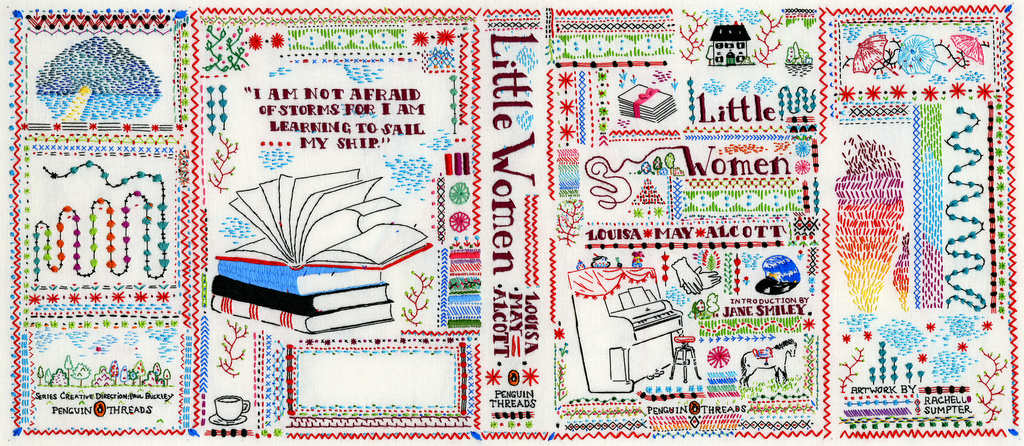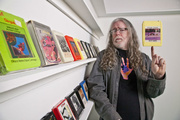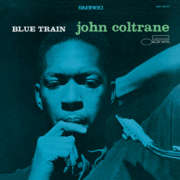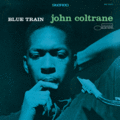
When Sarah O’Holla started her blog “My Husband’s Stupid Record Collection,” its title was a playful nod to the 1,500-album elephant in the room, poking fun at the snobbish seriousness of collectors like her partner, Alex Goldman. Despite packing and unpacking Goldman’s vinyl collection for five different moves over the course of their nine-year relationship, O’Holla had only listened to a small sliver of his music. So in a recent moment of inspiration, O’Holla set out to conquer the entire collection, writing a review for every album from A to Z.
“I think most people in the world don’t listen to music for intellectual stimulation, they listen to it for emotional and physical stimulation.”
With its refreshing, stream-of-consciousness style, O’Holla’s blog disregards the conventions of contemporary music writing—she dissects each album’s art, lyrics, and sound from the perspective of an open-minded amateur, rather than a haughty critic, Googling specific musicians and industry jargon while she listens. For example, take this excerpt about a track on the Barbarians’s self-titled album from 1965: “It feels like one of those classic break-up rock-and-roll songs from the 1960s. Lots of ‘babys,’ some call-and-response and a pretty jamming guitar. It sounds like summer. I imagine listening to this on a record player in your bedroom, laying in bed all sweaty because it’s just too hot out, and you can see the moon shining in your window.” In many blog entries, Goldman chimes in with esoteric details his own personal connections to the music at hand.
Seemingly overnight, the project struck a chord with a wide variety of audiences: Lifelong music nerds enjoyed O’Holla’s irreverent take on their obscure favorites, while rookies loved discovering new music through her accessible writing. But the blog is not without its detractors, some of whom claim it reinforces stereotypes about gendered realms of knowledge (a criticism that seems more appropriate for the Internet response at large, rather than O’Holla’s methods or intention). “As acquaintance after acquaintance—almost all of them men—enthusiastically shared the blog, I noticed a more powerful, gendered slant to their appreciation of it,” Judy Berman wrote for Flavorwire. Yet O’Holla’s project also challenges sexist stereotypes about record collecting as she experiences each album on her own terms, without letting Goldman or others mansplain them for her.
As O’Holla wrote in a response to her loudest critics, “I decided to be courageous enough to talk about something as a layman, to focus on emotions and the way the music was making me feel and certain memories or stories it would conjure up, rather than the fact that I don’t know how to write about music. These thoughts are me. These are my opinions formed from my experiences. And yes, I happen to be a woman writing about her experiences and having an opinion. I guess that’s still controversial these days.”

Top: O’Holla with Biff Bang Pow’s “The Acid House Album.” Above: O’Holla’s latest review is for the self-titled Black Eyes album from 2002.
O’Holla’s project also highlights an undervalued aspect of a decades-long collecting habit: Objects like records serve as a proxy for their owners’ personal history and offer the opportunity to share these past experiences with others. Like many record-obsessives, Goldman’s collection is intimately tied to his life, from his days pilfering vinyl from his older brother to those attending his friends’ basement punk shows. The records in his collection may contain favorite tracks, but they also conceal untold memories, neatly filed away until the needle hits a certain groove.
While Goldman’s audio-mania carries over to his day job as a producer for WNYC, O’Holla’s nostalgia-tinged passion is for books and writing, which helps explain why she’s now a librarian for a K-8 school, and why she likes to blog. Now firmly into the “B”s, we chatted with O’Holla and Goldman about the project’s notoriety and the ways art can be appreciated by insiders and outsiders.
Collectors Weekly: What initially sparked the blog idea?
Sarah O’Holla: It was really one specific moment. We had a friend over, and were hanging out the living room, drinking wine, and listening to records. I kept getting up to change the records and just had this thought, “There are so many records I haven’t listened to, maybe I should try and listen to all of them and write about it.” I’ve been blogging for a long time, and I love coming up with new ideas for things to write about.
The fact that we just moved also had a big influence—we moved from a one-bedroom apartment in Brooklyn to a house in New Jersey. In our apartment, we had our records in the same space as the computer, which has all of Alex’s MP3s and things like Spotify on it. We were recently in a phase of not listening to records that often because they are a little more involved, in that you have to keep getting up to flip them over or physically pull them out. Putting on your Spotify playlist is so much easier. But with our new house, our computer’s upstairs.

A few of the 15 boxes required for moving Goldman’s record collection.
Alex Goldman: And the record player’s in the living room.
O’Holla: So that was part of the reason we were listening to records. I was remembering how much fun it is and how interesting it can be to pull something out and look at it. And then I realized how many I hadn’t ever listened to, in all these years of living with this collection that’s already been curated for me.
Goldman: Not to say that it’s been curated well, but it has been curated.
O’Holla: I think Alex has good taste in music, or at least interesting taste, that lets me discover things I’ve never heard of before, not just the very mainstream, top-40 bands. Although, he does have some stuff like that.
Collectors Weekly: At what point did you start collecting records, Alex?
Goldman: I’m 34, and I became conscious of music when I was about 11 or 12, in 1991 or ’92, right about the time Nirvana got big. Nirvana was like a gateway drug into more indie bands. At the same time, CDs were taking prominence and everybody was unloading their vinyl collections. Suddenly the market was flooded with records. I was in the Midwest, and they were being sold at yard sales and record stores really cheaply. As a kid with only paper-route money to spend—I had to paper route from 9 to 14—or a hundred bucks a month, I had to stretch my dollar. So I started buying records because I could get a full album for just $3 or $4. Once I started getting really into music, I realized, oh, my God, records are so much cheaper, and they’re everywhere.
Also, if I went to a new music store, I’d find mostly contemporary stuff, the latest CD by Soundgarden or whatever. But if I went the record store, I could find 40-year-old records by crazy bands I’d never heard of. So I just started digging.
If something had an interesting cover and was cheap, I would definitely buy it. But there were also people who I considered oracles, mostly record store employees. I would be hanging around in there long enough that they’d be like, “Just get this album. You’re 14. I don’t want to deal with you.”

Like a scene straight out of “High Fidelity,” Goldman spent his formative years hanging around record stores and learning from the masters.
Collectors Weekly: Sarah, is collecting in your genes, too?
O’Holla: As a kid, I definitely had collections. I had a postcard collection. Actually, there was a time where I had a receipt collection. It feels like something I grew out of, but I do remember having that feeling of enjoying starting a collection.
“She doesn’t place him in the pantheon of free jazz luminaries and doesn’t give him this bullshit respect that people think he deserves before they ever start talking about him.”
I guess I could say I collect books, not rare books or anything like that, but I love having books in my house, and it’s hard to resist buying them. As a librarian, I also use the library a lot. I’ve read lots of great books that I don’t own, similar to how there’s a lot of music in Alex’s collection that he doesn’t have on vinyl. He has all the Beatles’ albums, but only one on vinyl.
I don’t buy books that often because I get to read them for free right away when they get into libraries. But there are definitely times I can’t resist. I actually have three copies of “Little Women.” I have the one from my childhood, and then I have a hardcover copy that my mom gave me, and a new soft-cover copy that looks like needlepoint on the front cover. It has those pages that are very jagged and rough-cut on the sides, and the tactile aspect of it was so intoxicating. I haven’t actually read that copy of the book—I wanted it because I love “Little Women,” but also because of what the book felt and looked like.

The 2011 paperback edition of Louisa May Alcott’s “Little Women,” one of O’Holla’s most cherished books, is covered in an image of hand-embroidery by Rachel Sumpter.
Collectors Weekly: As a librarian, are you frequently exposed to old or forgotten books?
O’Holla: Yeah, that’s the best part about being a librarian. There are so many gems, and the only reason I know about them is because I get to browse and re-shelve and things like that. My school started in the early ’70s, and though our catalog is on the computer now, we still have a lot of books with the original cards in them with signatures from students, some going back decades. It’s hard, though, because as a librarian, you still have to do what we call “weeding,” and sometimes you get rid of these older books that no one is reading. But we have many great out-of-print children’s books.

“Jellybeans for Breakfast,” from 1968, is one of O’Holla’s favorite out-of-print books.
Goldman: Do you recommend any of those a lot?
O’Holla: One of my favorite picture books of all time is called “Jellybeans for Breakfast,” and we read it aloud every year. We’ve actually put it behind the desk because it’s falling apart. It’s from the 1960s, and it’s out of print. I think the copies on Amazon go for a couple hundred dollars, so we don’t want it to totally fall apart because we can’t buy a new copy. The librarians always make sure to read it to the kids, and if a parent asks to check it out they can. But we took it out of circulation because it was too precious. It’s such a good book, though, it really should go back in print. I think librarians should help decide what gets reprinted.
Collectors Weekly: Alex, what kind of satisfaction do you get from your music collection?
Goldman: That’s changed over time. There was a time in the 1990s where the only way I could hear a certain album was if I went out and found it. Ultravox! albums weren’t being reissued on CD, and there was no Napster. So if I found it in a record store, suddenly there was a piece of this culture that I felt a part of, and I could experience it whenever I want. It was so gratifying.
Recently, I’ve been purchasing fewer records because the glut of records that came on the market when I started collecting has dwindled. Vintage vinyl has had this resurgence in the past couple of years, so good stuff is harder to find and a lot more expensive.
In the mid-2000s, I got really into dance music, so I started buying a lot of dance-music singles. At first, I was like, “I’m going to get contemporary electro and old-school disco and this and this.” But just when I felt like my collection started to catch up to the present, that was the moment when dance musicians stopped putting out stuff on vinyl. I remember it clearly because Azealia Banks released a song called “212,” and it wasn’t on vinyl because everybody’s using Serato or digital turntables now. I actually feel like the new LP is the cassette. There’s a lot of people getting into cassettes right now. Our friend Michael Troutman has a cassette-centric record label, or a cassette label, I guess.

Goldman does a little crate-digging while on vacation in Scotland.
Collectors Weekly: Before the blog, was Alex’s collection something you shared?
O’Holla: A little bit, but it always felt like more his thing. Whenever the pile of records got to be too messy, it was his job to put them away, because he knew how to do it better than I did. I knew how to use the record player and the other equipment, and I’ve definitely discovered a lot of music through his collection. But when I had the idea for the blog, I also realized I usually go to my favorites, bands that I already know, like Sonic Youth.
It’s tricky to put on an album that you’ve never heard of, especially because Alex’s taste is so eclectic. You could be getting a crazy hardcore punk band or you could be getting a sweet indie-pop band. Like most people, when I put on music I want it to fit the kind of mood I’m in, so that risk is a little too much sometimes.
Goldman: You probably aren’t going to remember this, but very early in our relationship, you were looking through my record collection for something to put on, and you pulled out a record by godheadSilo. I was like, “I don’t think you’re going to like this.” And you were like, “Why?” And I was like, “Look, you can put it on if you want, but I think you should pick something else.”
O’Holla: And what was it?
Goldman: It’s a band that’s just bass and drums, and it’s super distorted with this guy screaming. You’ll hear it soon enough.
O’Holla: Did I put it on?
Goldman: No, you didn’t.
O’Holla: But I might have liked it.
Goldman: You might have liked it. Judging by your reviews of Arab on Radar and Anthrax and bands like that, I’ve been very presumptuous. I’ve learned amazing stuff about you as a result of this blog.

From O’Holla’s review of Arab on Radar: “It’s experimental, and does feel a little avant-garde, like the people who are making it are artists and probably interesting people. Sometimes it just doesn’t feel like music. It just feels like sounds. I would definitely see this band live though.”
Collectors Weekly: Do your respective relationships to making music impact the way you listen to records?
O’Holla: Yeah, so much. Alex makes music, and he hears it very differently than I do. He claims he doesn’t care about lyrics, although he knows the lyrics to more songs than I do. I’m actually pretty tone deaf, but he’s very good at singing on key. We both have very emotional responses to music, but they’re sometimes totally different. Alex often has more extreme reactions to music than I do; he just gets really excited about it. I’m kind of jealous of that, actually.
“It’s a happy accident of playing records. Sometimes they sound interesting at the wrong speed.”
Goldman: I play guitar, and in the past, I’ve performed music. I’ve played in bands for a long time, and I’ve also done my own weird stuff, solo-ambient-noise-experimental music. But I don’t have a lot of formal training. I’m not good at reading music or anything like that, but I have a decent ear to pick up a melody on guitar. When I listen to music, my impulse is to break it down into its component parts in my head. I’ll be like, “Oh, that thing happening right now was done this way.” And once I do that, it helps me visualize a song in a way.
Like Sarah said, I think I interface with music on a more emotional level. There are levels of knowledge, and for a musician, I think I’m on the lower side of the comprehension scale. But as a listener of music, I may be on the higher end of the comprehension scale.

O’Holla with the reissue of the Barbarians’ self-titled album.
Collectors Weekly: Sarah, have you discovered things about Alex’s collection that he didn’t know?
O’Holla: Definitely, because there are some albums he’s barely listened to. The one that I really think of was the Barbarians record. Alex had maybe listened to it once, and it was originally a gift. The album wasn’t that remarkable, but there’s one song on it called “Moulty,” which is the drummer’s last name. It’s about how when he was a teenager, he made this homemade bomb.
Goldman: And he blew his hand off.
O’Holla: So he had a hook, and in the 1960s, he drummed with it for the Barbarians. And this song, “Moulty,” is this inspirational song about that experience. He’s just talking about how he had this dark time in his life, and he thought he lost control over his dream to be a drummer, but then he was able to do it anyway. And then the chorus is just people going, “Moulty!” and chanting his name. It’s really, really good.
Goldman: The best part of it is at the end, he’s like, “I kept with my dream and I got everything I want, and all I need now is a girl who will love me.” It’s so nuts. I can’t believe I’d never listened to it, and I’ve had it for a decade.
O’Holla: So, yeah, I found that gem.
Collectors Weekly: Why do you think the blog hit such a nerve for so many people?
O’Holla: I think many people connected with it because it was such a different way to write about music. I’ve had musicians and music writers and DJs and record collectors all reach out and say that they loved it, but also a lot of ordinary people like me. I think it’s the collection, too. Alex has a collection that lots of music nerds appreciate, and they’re excited to see certain bands written about.
From the beginning, I intentionally wrote about my emotions because that’s the only thing I already had a vocabulary for. And I honestly think that’s how most people listen to music. Music is often written about very analytically, in an intellectual way, but I think most people in the world don’t listen to music for intellectual stimulation, they listen to it for emotional and physical stimulation, like how it makes your body feel.
Goldman: Correct me if I’m wrong, but you didn’t overthink it. You just started writing. The only rule was to listen to the whole record and write as you listened. But I think people like the blog for a couple of reasons. For one, I think it’s a totally new way of writing about music. It’s not about context; it’s about the very immediate feeling. Sarah doesn’t necessarily know an artist like Albert Ayler, so she doesn’t place him in the pantheon of free jazz luminaries and doesn’t give him this bullshit respect that people think he deserves before they ever start talking about him.

O’Holla’s first review, for “Song Hits of 1939,” made her wax nostalgic about her grandmother’s childhood.
O’Holla: Some people do write about the emotional impact of music, but it usually includes that deeper context, which puts up a wall a little bit, like, “Oh, I’m not going to sound cool if I say that I don’t like this music that’s supposed to be really high-brow and great.”
Goldman: Once we’d gotten midway through the A’s, someone on Twitter was like, “He doesn’t have any Amon Düül records. He’s such a poser.” And that was honestly my biggest fear going into this—that people were going to judge my record collection. I think record collectors are a little self-important and take their hobby deadly seriously. Something I really like about this project that might piss other people off is that it says that record-collecting is not so important. In a subtle way, I think Sarah’s taking the piss out of me a little bit, and I like that.
O’Holla: Well, that’s definitely why the word stupid is in the title. Obviously, I think collecting records is great, but sometimes I roll my eyes about it.
Goldman: And I appreciate that. I’m fully aware that record-collecting in the era of music ubiquity is a little ridiculous as a hobby. But it’s what I do.

From O’Holla’s Soul Makossa review: “This is the type of song that you want people to slow dance to at your outside barbecue, under a full moon with the smell of wisteria in the air.”
Collectors Weekly: Were you surprised by the critical media response?
O’Holla: I did feel a little like this group of bullies wanted me to stop writing, but I didn’t. Honestly, their criticism made my blog a lot more popular. I don’t think Slate would have written about it if people hadn’t already criticized it. Beyond the popularity thing, I’m actually really happy it turned into a bigger conversation, and it’s not just a silly personal project anymore. I’m happy to talk about gender all the time, so let’s talk about it. Now it feels like I’m doing something a little more important.
Goldman: It was a little overwhelming at first.
O’Holla: I felt like people didn’t know me, but had this idea of who I was based on a few of my early posts, where my words weren’t that careful. There were certain things that get taken out of context. For the “Au Pairs” album, when I pulled it out, I had a dyslexic moment and read “Au Paris.” And I kept it in there because I thought that was funny.
Goldman: People turned around and were like, “Look at how stupid she is.” As far as I’m concerned, Sarah has balls of steel. After we came back from Scotland to all this press, for one of her first reviews, she listened to a record at the wrong speed—at 33 RPM when it was supposed to be 45 RPM.
We spent the entire night arguing over whether she should include that. I was like, “Don’t do it. You’re just feeding the fire. It’ll make people angry.” And Sarah was like, “Fuck them. I don’t care. I’ve been writing this thing honestly from the beginning, and I don’t give a shit.” And she left it exactly as it was. Afterward, Sarah posted an update with all these comments from people saying they’d made the same mistake. It’s totally common; it’s a happy accident of playing records. Sometimes they sound interesting at the wrong speed.
O’Holla: I liked it slow. I would listen to it again slow. The album was by Bad Manners, this ska band with a woman singing, and I thought it was a man. I thought it was a man singing very slowly, but it’s a woman singing pretty fast.

O’Holla with the Bad Manners album she first listened to at the wrong RPM: “After this embarrassing revelation, I went back and read my review, listening to the entire record again at the appropriate speed and I still felt exactly the same way.”
Collectors Weekly: Sarah, is there a children’s book you’d recommend to your blog’s naysayers?
O’Holla: One of my favorites is called “The Big Orange Splot” by Daniel Pinkwater. It’s a picture book about a neighborhood where all the houses look the same, and they call it their “neat street.” And then one day, a house gets an orange splot of paint on it accidentally, dropped by a bird flying by with a paint can. No one knows why, and the owner just goes with it. Instead of cleaning it up, he trips out his house with crazy murals, alligators on his lawn, and all sorts of amazing things.
At first, everyone on the street is really angry because all the houses are supposed to be the same, but eventually they come around and realize that a house that reflects who you are is the best house to have, and they all get creative with their own houses. So, my connection goes back to my idea that there isn’t just one way to write about music. My blog was a little bit like “The Big Orange Splot” house: It didn’t look like any other music writing out there, and it was causing a lot of attention. But I’d like to think I will inspire others to write about music, or anything really, in the way that I did—to trust your gut, and write in whatever way feels true to you.

For those unhappy with her blog, O’Holla suggests they read Daniel Manus Pinkwater’s “The Big Orange Splot.”
(All photos courtesy Sarah O’Holla. Listen to O’Holla’s recent interview with Soundcheck on NPR. If you buy something through a link in this article, Collectors Weekly may get a share of the sale. Learn more.)

 God Save the Eight-Track
God Save the Eight-Track
 Your Turntable Is Not Dead: Inside Jack White’s Vinyl Record Empire
Your Turntable Is Not Dead: Inside Jack White’s Vinyl Record Empire God Save the Eight-Track
God Save the Eight-Track Secrets of the Blue Note Vault: Rediscovering Monk, Blakey, and Hancock
Secrets of the Blue Note Vault: Rediscovering Monk, Blakey, and Hancock Punk and Hardcore Vinyl RecordsThe origins of punk are a hotly debated topic. Some say it really began in …
Punk and Hardcore Vinyl RecordsThe origins of punk are a hotly debated topic. Some say it really began in … Jazz Vinyl RecordsCollectible vinyl jazz records run the gamut from some of the earliest blue…
Jazz Vinyl RecordsCollectible vinyl jazz records run the gamut from some of the earliest blue… RecordsMore than a digitally perfect CD, and way more than a compressed audio file…
RecordsMore than a digitally perfect CD, and way more than a compressed audio file… Mari Tepper: Laying it on the Line
Mari Tepper: Laying it on the Line Nice Ice: Valerie Hammond on the Genteel Charm of Vintage Canadian Costume Jewelry
Nice Ice: Valerie Hammond on the Genteel Charm of Vintage Canadian Costume Jewelry How Jim Heimann Got Crazy for California Architecture
How Jim Heimann Got Crazy for California Architecture Modernist Man: Jock Peters May Be the Most Influential Architect You've Never Heard Of
Modernist Man: Jock Peters May Be the Most Influential Architect You've Never Heard Of Meet Cute: Were Kokeshi Dolls the Models for Hello Kitty, Pokemon, and Be@rbrick?
Meet Cute: Were Kokeshi Dolls the Models for Hello Kitty, Pokemon, and Be@rbrick? When the King of Comedy Posters Set His Surreal Sights on the World of Rock 'n' Roll
When the King of Comedy Posters Set His Surreal Sights on the World of Rock 'n' Roll How One Artist Makes New Art From Old Coloring Books and Found Photos
How One Artist Makes New Art From Old Coloring Books and Found Photos Say Cheese! How Bad Photography Has Changed Our Definition of Good Pictures
Say Cheese! How Bad Photography Has Changed Our Definition of Good Pictures Middle Earthenware: One Family's Quest to Reclaim Its Place in British Pottery History
Middle Earthenware: One Family's Quest to Reclaim Its Place in British Pottery History Fancy Fowl: How an Evil Sea Captain and a Beloved Queen Made the World Crave KFC
Fancy Fowl: How an Evil Sea Captain and a Beloved Queen Made the World Crave KFC
This is lovely, they sound lovely, and I’m listening to Soul Mokassa and loving it so thank you all round!
So happy to see someone else recommending The Big Orange Splot! As to the blog, I have read it and think it is awesome. There is no wrong way to appreciate music.
Her analogy with the Big Orange Splot is “spot on!”
Her blog is not the big orange splot. There are all sorts of music bloggers out there! Her blog is getting attention because her husband works for NPR. Can we stop pretending that this went viral for any other reason?
Do not listen to Oh Come On. what a cry-baby, bemoaning someone else’s good efforts. This is a project that every record collector, male or female, should appreciate, especially if you have a significant other that does not share the collecting bug. Keep on Rockin!
Awesome! I’m gonna have to read this blog: it sounds wonderful.
I feel like pretension and snobbery are the biggest enemies of good music. It’s actually kinda sad that people who *don’t* have a music education are more likely to take music at face value. If a piece doesn’t resonate with people, it doesn’t matter how cool or complicated or ground-breaking it is, it has failed as music. Tricks, techniques, styles, ornaments, arrangements, and all the rest exist to serve the music, and through the music the listener, not the other way around!
Excellent initiative !!!
More than impressed by the work done on that blog.
After having spent years of building a huge CD collection I started a record one a few years back. And I would be more than happy is someone else would go through it in some years and review it with fresh eyes !!!!!!
Once again, excellent !!!!